Clinical Research
(CR-064) Smart Insoles: Preventing Diabetic Foot Ulcers and Reducing Carbon Footprints
Friday, May 2, 2025
7:45 PM - 8:45 PM East Coast USA Time

Maria Caluianu, BSc, PhD, AFHEA – Biomedical Consultant, Walk With Path Ltd.; Richard Leigh, DPodM, BSc, MRCPod, FRCPodM, FFPM RCPS (Glasg)
Introduction: 5.6 million people are estimated to have diabetes in the UK. 25% of individuals with diabetes go on to develop diabetic foot ulcers (DFUs) in their lifetimes1. DFUs take significant time to heal and often lead to amputations. Current DFU prevention methods are inadequate, resulting in 40% of DFUs recurring within a year2. DFU treatment and amputations also have significant environmental costs due to the single-use consumables used in assessment and treatment which must be incinerated following use.
Methods: To tackle this, we hypothesize that using smart temperature- and pressure-sensing insoles to predict DFUs before they form and acting early can prevent DFUs and reduce the carbon footprint of DFU care. To this end, user testing and carbon footprint analysis were carried out on smart, DFU-predicting insoles*.
Results: The smart insoles had 8-16-fold smaller carbon footprint than any scenario where a patient develops a DFU. All users stated that they would act to prevent a DFU if DFU-predicting insoles* alerted them to do so. Most were comfortable with using phone apps and having their data collected and shared with their healthcare providers.
Discussion: We have shown that smart insoles can reduce the carbon footprint of DFUs and potential users are ready to adopt such devices into their care. Thus, smart DFU-predicting insoles present a promising device in DFU prevention.
Methods: To tackle this, we hypothesize that using smart temperature- and pressure-sensing insoles to predict DFUs before they form and acting early can prevent DFUs and reduce the carbon footprint of DFU care. To this end, user testing and carbon footprint analysis were carried out on smart, DFU-predicting insoles*.
Results: The smart insoles had 8-16-fold smaller carbon footprint than any scenario where a patient develops a DFU. All users stated that they would act to prevent a DFU if DFU-predicting insoles* alerted them to do so. Most were comfortable with using phone apps and having their data collected and shared with their healthcare providers.
Discussion: We have shown that smart insoles can reduce the carbon footprint of DFUs and potential users are ready to adopt such devices into their care. Thus, smart DFU-predicting insoles present a promising device in DFU prevention.

.jpg)